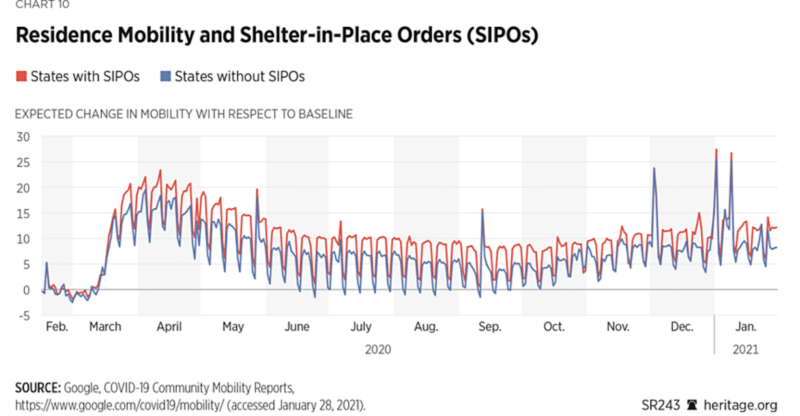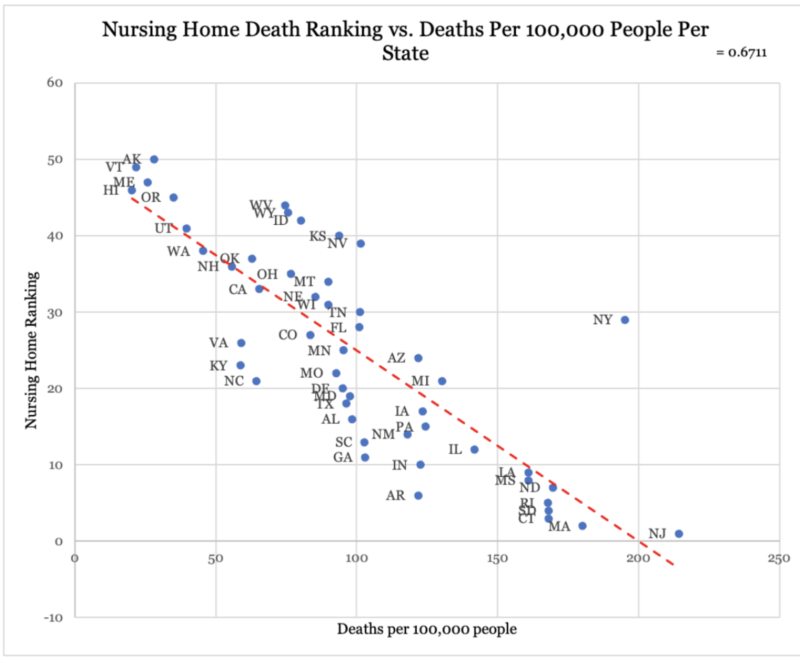
It should be safe to say that the United States is finally starting to move past Covid-19 as herd immunity nears closer and closer. The debate over whether lockdowns were a good pandemic response has been raging since day one with each side attempting to grasp at whatever immediate evidence is available.
The overwhelming evidence at this point seems to suggest that after controlling for various outliers, most sweeping policy responses like stay-at-home orders and business closures have very little correlation with stopping Covid-19. After factoring in the economic and social damage of lockdown policies, the case for their long-term use becomes untenable. This fact has been hinted at almost since the beginning of the pandemic and increasingly confirmed by the latest data.
Jeffrey Tucker noted all the way back in July of 2020 that,
“Already in mid-April questions arose. Prof Isaac Ben-Israel, head of the Security Studies Program at Tel Aviv University and the chairman of the National Council for Research and Development, looked at the data around the world and concluded that the virus comes and goes after 70 days regardless of the policies deployed. He found no relationship at all between locking down and transmission and death.”
In August of 2020, I noted in an analysis here that there seemed to be little correlation between lockdowns around the world and superior performance. Some of the strictest countries like Belgium and the United Kingdom had some of the worst results. Policies that seemed to work in some countries like Brunei were copied and replicated in other countries like Peru with little success.
In January of 2021, a study published by Stanford researchers comparing eight countries that implemented lockdowns with two counterfactuals that did not concluded the following,
“In the framework of this analysis, there is no evidence that more restrictive non-pharmaceutical interventions (“lockdowns”) contributed substantially to bending the curve of new cases in England, France, Germany, Iran, Italy, the Netherlands, Spain, or the United States in early 2020. By comparing the effectiveness of NPIs on case growth rates in countries that implemented more restrictive measures with those that implemented less restrictive measures, the evidence points away from indicating that mrNPIs (major interventions) provided additional meaningful benefit above and beyond lrNPIs (light interventions).”
In April of 2021, Amelia Janaskie and I published an analysis of a pandemic response ranking put out by the Othering and Belonging Institute at UC Berkeley. The ranking attempted to score the performance of states based on cases, deaths, and testing. However, when we compared the rankings given by the Institute with deaths per capita per state, we found a weak correlation. Furthermore, the ranking failed to account for economic and social damage which is admittedly hard to quantify but extremely important when comparing pandemic policies.
Perhaps some of the most insightful data that discredits the necessity and effectiveness of lockdown policies is this report from the Heritage Foundation. In particular, it noted that people in states without lockdowns voluntarily reduced their mobility as Covid-19 cases and deaths spiked. That is why regardless of lockdowns, Covid cases and deaths seem to follow similar patterns as people voluntarily take measures to slow the spread.
Lockdowns not only artificially reduced activity beyond necessary thresholds, they created undue social as well as economic strife. Provided below is a chart demonstrating mobility data in states with stay-at-home orders and those without. It is clear that in states without stay-at-home orders, individuals still voluntarily reduced their mobility in response to rising cases and deaths. The stay-at-home orders only produced more severe reductions in activity that were likely unnecessary.

We should not pretend that there would not have been economic and social damage without lockdowns. Pandemics certainly cause recessions and social upheaval but lockdown policies exacerbate these issues while promising little in return. In an article here, Jack Nicastro and I explored how despite the historic association of recessions with pandemics, lockdowns made the Covid-19 downturn much worse.
Why Focused Protection?
The late Dr Donald Henderson, most famous for leading the eradication of smallpox, noted in an essay on responding to pandemics that,
“Experience has shown that communities faced with epidemics or other adverse events respond best and with the least anxiety when the normal social functioning of the community is least disrupted.”
He was responding to a debate on whether experimental lockdown policies that affected vast swathes of society would be more effective than more light-handed and focused policies. Building on this idea and in the face of growing evidence, the idea of focused protection was famously articulated by the Great Barrington Declaration in October 2020. Although it is up to interpretation as to what that means in specific contexts, it largely advocates for light-handed policies rather than lockdowns. It advocates for the majority of society to practice voluntary decision-making while taking important steps to shield vulnerable populations.
The efficacy of this approach in hindsight is demonstrated by the mobility data comparison mentioned above and the performance of states like Florida and Texas, among others that have ended most if not all of their lockdown policies. More importantly, it appears that success in protecting vulnerable populations such as nursing homes rather than implementing lockdowns explains far more about why certain states had more deaths than others.
There is a strong correlation between deaths per capita and the proportion of nursing home populations lost to Covid-19 as shown by this graph here.

Although nursing home residents comprise about 1 percent of the US population, they make up about 40 percent of all Covid deaths; in Sweden that number is 50 percent. This information points us in a direction that suggests that minimizing Covid deaths is not about closing schools and businesses, but ensuring that nursing homes are protected. This notion is supported by an analysis published by two researchers at AIER that found when total Covid deaths per state are plotted with total nursing home populations per state,
“The trendline shows a strong correlation between the two variables (R-squared = 0.68), suggesting that the level of deaths within a state may be related to the number of LTC residents.”
Florida is perhaps one of the best examples in the US of a state that took steps to shield nursing home patients, which resulted in relatively low deaths compared with the rest of the country despite having one of the oldest populations. The Palm Beach Post writes,
“In contrast, (Ron) DeSantis prohibited Florida hospitals from discharging patients with the disease to the state’s 4,400 long-term care facilities, which are home to 150,000 residents and employ 200,000 people.
That policy, he said, is one of the key reasons an average of only two elder-care residents per 100,000 people have died in Florida since the pandemic began in mid-March. The actual number is 3.5 per 100,000.
In New Jersey, out of every 100,000 people in the state, 51 nursing home residents have died. In New York, nearly 27 have died. Even Colorado, which has had a comparatively low 1,067 deaths, more than 10 nursing home residents have died per capita.”
In light of this information, it seems that much of the death toll associated with Covid-19 would have been avoided had policymakers focused on protecting vulnerable populations such as nursing homes, rather than shutting down all of society.
Key Takeaways
As the United States nears the hopeful end of its public health crisis, the mounting evidence domestically and abroad seems to suggest that harsh lockdown policies were not only overkill, they were counterproductive. The data suggest little correlation between minimizing deaths and lockdown style policies, but a strong relationship with protecting vulnerable populations. It is important to understand that pandemic policies do not occur in a vacuum. On top of not stopping the virus, they unleash economic, social, and institutional damage. In light of this information, it is increasingly apparent that a strategy of focused protection which respects the voluntary functions of society while taking reasonable steps to accommodate vulnerable populations would have been the most optimal pandemic response.


0 Comments